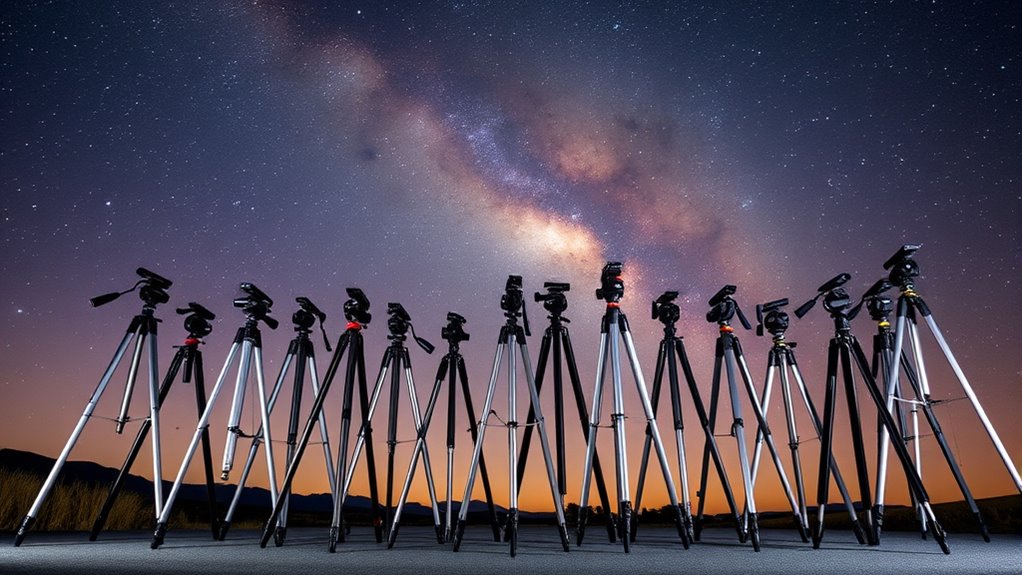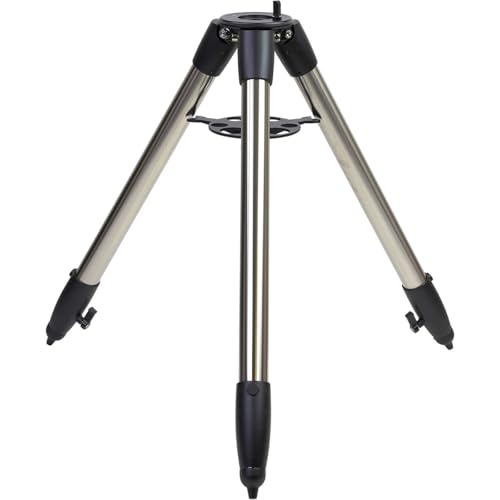If you’re seeking the best tripods and pier mounts for astrophotography, I suggest checking out options like the Sky-Watcher Star Adventurer GTI, iEXOS-100-2, and iOptron Mini Pier. These are lightweight, sturdy, and highly portable, perfect for precise tracking and stability during long exposures. Heavy-duty mounts like the Orion Steel Tripod and iOptron Tri-Pier provide even more support for serious setups. Keep exploring to find the ideal gear that matches your needs and imaging goals.
Key Takeaways
- Heavy-duty steel and machined aluminum tripods like Orion Steel Tripod and Pier offer exceptional stability for long-exposure astrophotography.
- Portable, high-capacity supports such as the iOptron Tri-Pier provide robust load capacity with foldable designs for outdoor use.
- Versatile tripods like NEEWER 72 Inch support multiple accessories, featuring multi-angle legs and quick-release plates for ease of setup.
- Lightweight, portable mounts like Sky-Watcher AZ-GTI and Star Adventurer GTI are ideal for beginner and casual astrophotographers.
- Compatibility, durability, and vibration reduction are key factors in selecting the best tripods and pier mounts for precise astrophotography.
Sky-Watcher Star Adventurer GTI Mount Kit
If you’re looking for a portable and feature-rich mount for astrophotography, the Sky-Watcher Star Adventurer GTI Mount Kit is an excellent choice. It’s compact, lightweight, and offers full GoTo capabilities, making it perfect for travel and beginner setups. The built-in illuminated polar scope simplifies alignment, while Wi-Fi connectivity lets you control it with your smartphone. Supporting multiple tracking rates and a payload capacity of 11 pounds, it works well with DSLR cameras, small telescopes, and astrographs. The kit includes a full mount head, tripod, counterweights, and accessories, providing a versatile, user-friendly platform for capturing stunning night sky images.
Best For: amateur astronomers, travel enthusiasts, and beginners seeking a portable, feature-rich astrophotography mount with easy alignment and smartphone control.
Pros:
- Compact, lightweight, and highly portable for travel and field use
- Full GoTo capabilities with accurate tracking and easy target acquisition
- Built-in illuminated polar scope simplifies alignment process
Cons:
- Fragile components such as polar scope rear cover and battery compartment may require careful handling or modifications
- Limited payload capacity of 11 pounds may restrict larger telescopes or heavy accessories
- Some users experience software or hardware quirks that may necessitate updates or adjustments
iEXOS-100-2 PMC-Eight Equatorial Tracker System for Astrophotography
The iEXOS-100-2 PMC-Eight Equatorial Tracker System stands out as an excellent choice for amateur astrophotographers seeking precise tracking with user-friendly controls. Its integrated PMC-Eight system uses eight independent CPUs for fast, reliable responsiveness, while quiet stepper motor belt drives ensure smooth operation. The mount features intuitive app control via ExploreStars, supporting star alignment, navigation, and celestial data access. Built with quality materials, it’s portable and easy to assemble, handling lightweight gear effectively. Although initial GoTo accuracy may require calibration, it offers stable guiding and excellent value for beginners. Its WiFi and Bluetooth connectivity make remote operation simple, making it a versatile tool for astrophotography enthusiasts.
Best For: amateur astrophotographers seeking an affordable, portable, and user-friendly equatorial tracker with reliable tracking capabilities.
Pros:
- Integrated PMC-Eight system with eight CPUs ensures fast and responsive operation.
- Quiet stepper motor belt drives provide smooth and stable tracking during astrophotography sessions.
- Easy-to-use ExploreStars app allows for quick star alignment, navigation, and celestial data access.
Cons:
- Initial GoTo accuracy may require calibration adjustments for precise pointing.
- Tripod legs can be somewhat flimsy and may need additional tightening or modifications for stability.
- Limited azimuth adjustment features and occasional control software stability issues can require troubleshooting.
Sky Watcher Star Adventurer Tripod
For amateur astronomers seeking a reliable, lightweight tripod that can handle various astrophotography setups, the Sky Watcher Star Adventurer Tripod (Model S20555) stands out as an excellent choice. It measures 36 x 54 x 36 inches, weighs around 4.99 pounds, and is compatible with popular mounts like Star Adventurer Mini and GTi, as well as many telescopes. Made from quality materials, it offers impressive stability, adjustable height, and easy setup. Its accessory tray twists 45° for added stability. Rated 4.7 stars, users praise its durability and support for heavy payloads, making it a versatile, portable option for both beginner and advanced astrophotographers.
Best For: amateur astronomers and astrophotographers seeking a lightweight, stable, and versatile tripod for various telescope setups and astrophotography activities.
Pros:
- Highly stable and rigid construction that supports heavy payloads without flexure
- Adjustable height with easy setup, ideal for different observing and imaging needs
- Compatible with multiple mounts and telescopes, enhancing versatility
Cons:
- Some users have noted minor misalignment issues with the accessory tray tabs, though this is intentional for stability
- Slightly heavier than ultralight tripods, which may impact portability for some users
- Limited to specific mount compatibility, so users with incompatible gear may need adapters
iOptron Mini Pier Tripod Extension for Mounts
Designed to elevate GOTO mounts like the CEM60, iEQ45, and MiniTower series, the iOptron Mini Pier Tripod Extension offers a straightforward way to improve your astrophotography setup. It raises your mount by 8 inches, enhancing viewing angles and reducing ground obstructions. Made from durable materials, it provides added stability and helps minimize vibrations for sharper images. Compatibility includes a 5.7-inch pier diameter and 6-inch flange plates, ensuring easy integration. While some users report assembly challenges and minor stability issues, many appreciate its lightweight design and improved polar alignment potential, making it a versatile upgrade for serious astrophotographers.
Best For: Serious astrophotographers and telescope enthusiasts seeking to improve stability, viewing angles, and polar alignment capabilities with compatible GOTO mounts like CEM60, iEQ45, and MiniTower series.
Pros:
- Elevates mounts by 8 inches, enhancing viewing angles and reducing ground obstructions.
- Made from durable, high-quality materials that provide stability and minimize vibrations.
- Facilitates more accurate polar alignment, improving tracking and image clarity.
Cons:
- Some users report assembly difficulties due to lack of detailed instructions.
- Small mounting screws and misaligned holes can affect stability and require modifications.
- Weak connections and vibrations under load may compromise overall stability for certain setups.
Sky-Watcher AZ-GTI Portable GoTo Alt-Az Mount
If you’re looking for a portable mount that combines ease of use with reliable tracking, the Sky-Watcher AZ-GTI Portable GoTo Alt-Az Mount is an excellent choice. Weighing just 8.6 pounds, it’s perfect for mobile astronomy and quick setups. It supports payloads up to 11 pounds, suitable for small telescopes and DSLR cameras. The adjustable aluminum tripod extends from 28 to 53 inches and can connect to standard photographic tripods. Controlled via WiFi with the SynScan Pro app, it offers precise, smooth tracking for celestial, lunar, and planetary observations. Its manual slewing and firmware updates make it versatile, though occasional WiFi issues can occur.
Best For: beginners and amateur astronomers seeking a lightweight, portable mount for quick setup and reliable tracking of small telescopes and cameras.
Pros:
- Compact, lightweight design weighing only 8.6 pounds for easy portability
- Supports payloads up to 11 pounds, suitable for small telescopes and DSLR cameras
- Controlled via WiFi with the intuitive SynScan Pro app for precise, smooth tracking
Cons:
- Occasional WiFi disconnection issues can disrupt operation
- Limited load capacity may restrict use with larger or heavier equipment
- Not optimized for long-exposure astrophotography without additional accessories like a wedge
iOptron SkyHunter Extension Pier and Tripod
The iOptron SkyHunter Extension Pier and Tripod stands out for astrophotographers seeking a sturdy and compatible mount system. Made from stainless steel, the tripod weighs 24 pounds and supports various mounts, including SkyHunter, SkyGuider Pro, and SkyTracker Pro, thanks to its 3/8-16 threads. The aluminum extension pier measures 7.5 inches tall, providing extra height and stability. Its flange diameter of 82mm and tube diameter of 58mm ensure solid support. With a versatile mounting setup, robust construction, and excellent customer ratings, this tripod and pier combo offers a reliable foundation for precise astrophotography.
Best For: astrophotographers and hobbyists seeking a durable, versatile tripod and pier system compatible with multiple mounts for stable and precise celestial imaging.
Pros:
- Made from sturdy stainless steel and aluminum for durability and stability
- Supports a variety of mounts with 3/8-16 and M6 mounting options
- High customer ratings (4.7/5 stars) indicate reliable performance and quality
Cons:
- Heavy at 24 pounds, which may be less portable for travel
- Limited to specific mount types; not compatible with all camera or telescope setups
- The 7.5-inch pier extension may not provide sufficient height for all users and setups
iOptron Tri-Pier for GoTo Mounts
For astrophotographers seeking a stable yet portable support for their GoTo mounts, the iOptron Tri-Pier stands out thanks to its impressive load capacity of up to 220 pounds. Its robust design minimizes vibrations, ensuring sharper images and more precise tracking. Weighing only 25.8 pounds, it’s surprisingly lightweight for its strength, and its folded dimensions make transportation effortless. The adjustable height, from 31.5 to 42.5 inches, offers flexibility for comfortable viewing, while the leveling system handles uneven terrain with ease. Compatible with a wide range of mounts thanks to its 5.7-inch pier diameter and 150mm top plate, it’s a versatile choice for outdoor astrophotography.
Best For: astrophotographers and astronomers who need a stable, portable support system for their GoTo mounts during outdoor observations and imaging sessions.
Pros:
- Supports up to 220 lbs, accommodating various telescope setups with ease.
- Lightweight and portable at only 25.8 lbs, with compact folded dimensions for easy transport.
- Adjustable height (31.5 to 42.5 inches) and leveling system for uneven terrains, ensuring comfortable and stable setup.
Cons:
- May require additional accessories for specific mount compatibility.
- Limited to outdoor use; not suitable for indoor or fixed installations.
- The size and weight, while portable, may still be cumbersome for some users to carry over long distances.
Celestron Heavy Duty Alt-Azimuth Tripod
When selecting a tripod for astrophotography, stability and versatility are essential. The Celestron Heavy Duty Alt-Azimuth Tripod offers robust aluminum legs supporting up to 11 lbs, making it suitable for small telescopes, binoculars, and cameras. Its adjustable height from 30.9 to 49.2 inches fits various observation setups. The fully adjustable legs and center brace enhance stability, while the alt-azimuth head with slow-motion controls allows precise adjustments. Lightweight at 7.8 lbs, it’s portable and easy to set up, perfect for casual astronomy and outdoor use. However, it’s less ideal for prolonged tracking or larger instruments due to some structural limitations.
Best For: casual astronomers, outdoor enthusiasts, and beginners seeking a portable, stable tripod for small telescopes, binoculars, or cameras.
Pros:
- Sturdy aluminum construction provides excellent stability and minimizes vibrations.
- Lightweight and portable, making it easy to transport and set up outdoors.
- Fully adjustable height and smooth slow-motion controls facilitate precise adjustments.
Cons:
- Limited coarse altitude control and no tilt lever can make adjustments less effortless.
- Small parts like adjustment screw covers can be fragile or break easily.
- Not suitable for heavy or large telescopes requiring more precise tracking or longer durations.
Sky-Watcher AZ5 Telescope Mount
If you’re starting out in astrophotography or seeking a reliable mount for terrestrial viewing, the Sky-Watcher AZ5 Telescope Mount stands out due to its lightweight design and user-friendly features. Made from durable cast aluminum, it offers stability with adjustable steel tripod legs and supports optical tubes up to 15 pounds. The mount’s geared slow-motion controls provide precise manual tracking, while the included pier extension and accessory tray add convenience. Its smooth, vibration-free operation makes it suitable for both beginners and enthusiasts. Weighing just 12 pounds, it’s portable yet sturdy enough for small to medium telescopes, ensuring reliable performance across various observation environments.
Best For: beginners and amateur astronomers seeking a lightweight, stable, and easy-to-use mount for visual astronomy and terrestrial observations.
Pros:
- Durable all-metal construction ensures long-term reliability and stability.
- Geared slow-motion controls provide precise manual tracking of celestial objects.
- Adjustable tripod legs allow flexibility in setup and observing positions.
Cons:
- Some users report manufacturing issues with the extension’s threading, affecting stability.
- Limited payload capacity of 15 pounds may restrict larger or heavier telescopes.
- Warranty support and component replacement can experience delays due to quality control concerns.
DaVoice 44mm Tripod Quick Release Plate Camera Mounting Adapter
The DaVoice 44mm Tripod Quick Release Plate is an excellent choice for astrophotographers who need to quickly switch between cameras or devices without sacrificing stability. It features a sturdy plastic build with a rubber top for a secure grip, along with a metal pin and thumb screw for tool-free attachment. Designed for tripods with a 44mm square mount, it’s compatible with popular models like Amazon Basics and Sony tripods. Weighing just under an ounce, it’s lightweight yet reliable. This adapter simplifies setup, making it ideal for rapid camera changes during astrophotography sessions, with positive reviews praising its fit, durability, and value.
Best For: photographers and astrophotographers who need a reliable, quick-release adapter to switch cameras or devices on compatible tripods efficiently.
Pros:
- Easy tool-free attachment with metal thumb screw and pin for quick setup.
- Durable plastic build with a rubber top for secure grip and stability.
- Compatible with a variety of popular tripod brands like Amazon Basics and Sony, ensuring versatility.
Cons:
- Some users report fragility and potential breakage under heavy or repeated use.
- Compatibility depends on precise measurement of tripod base size; incorrect sizing may cause fitting issues.
- Not suitable for tripods with mounts larger or smaller than 44mm x 44mm, limiting universal applicability.
NEEWER 72 Inch Camera Tripod with Monopod and Ball Head
For astrophotographers seeking versatility and stability, the NEEWER 72 Inch Camera Tripod with Monopod and Ball Head stands out as a top choice. Its durable aluminum alloy construction supports gear up to 33 pounds, with a sturdy carabiner for added stability. The four-section legs extend to 72 inches and can be adjusted for various angles or removed to create a monopod. The multi-angle center column offers precise vertical and horizontal positioning, perfect for framing celestial objects. The included ball head has three knobs and bubble levels for accurate adjustments. With its compatibility with major DSLR brands, this tripod delivers both flexibility and dependable support for astrophotography.
Best For: astrophotographers and outdoor photographers seeking a versatile, stable tripod that can be easily adapted for different shooting scenarios.
Pros:
- Supports camera gear up to 33 pounds, ensuring compatibility with most DSLR cameras and camcorders.
- Adjustable legs and multi-angle center column provide precise framing and flexibility for astrophotography.
- Includes a sturdy ball head with bubble levels for accurate adjustments and quick release compatibility.
Cons:
- Heavier than some lightweight tripods, which may affect portability for extended outdoor shoots.
- The multi-section legs and twist locks may require some effort to extend and secure firmly.
- The maximum height of 72 inches might be limiting for very tall users or specific shooting angles.
Sky Watcher Star Adventurer GTI Mount Head Kit
The Sky Watcher Star Adventurer GTI Mount Head Kit stands out as an excellent choice for portable astrophotographers who prioritize lightweight design and versatile tracking. Weighing around 15 pounds, it’s compact enough to travel with easily, yet robust enough to support up to 11 pounds of gear. Its built-in Wi-Fi and app control make setup straightforward, while the illuminated polar scope aids alignment. With multiple tracking modes—sidereal, lunar, and solar—it handles a variety of astrophotography needs. Although some users report minor quality issues, overall, it delivers smooth tracking and reliable GoTo performance, making it a versatile tool for both beginners and experienced astrophotographers on the go.
Best For: portable astrophotographers seeking a lightweight, versatile, and user-friendly mount for capturing deep-sky, lunar, and planetary images with minimal setup.
Pros:
- Compact, lightweight design weighing around 15 pounds for easy portability
- Built-in Wi-Fi and app control simplify setup and alignment processes
- Supports multiple tracking modes (sidereal, lunar, solar) for diverse astrophotography needs
Cons:
- Some users report quality issues with polar scope accessories and battery compartments
- GoTo accuracy may vary, requiring careful calibration for precise pointing
- Certain components like polar scope illuminators and plastic parts are prone to malfunction or damage
EQ6 Tripod to Wave Steel by Sky-Watcher
If you’re aiming for stability and compatibility with Sky-Watcher mounts, the EQ6 Tripod to Wave Steel by Sky-Watcher stands out as an excellent choice. Its robust 2-inch rolled steel legs deliver exceptional stability, reducing vibrations and enabling smooth tracking during observations. Designed mainly for Sky-Watcher Wave mounts, it also supports NEQ6, EQ6, EQ6-R, and AZ-EQ6 mounts, offering versatility. To securely attach a Wave Mount, you’ll need a Wave Pier Adapter (S30916). With its sleek black trim and professional look, this tripod provides a reliable, sturdy foundation for astrophotography, ensuring clear views and precise tracking.
Best For: astronomers and astrophotographers seeking a stable, compatible tripod for Sky-Watcher Wave mounts and similar EQ6 series mounts.
Pros:
- Robust 2-inch rolled steel legs provide excellent stability and vibration reduction.
- Compatible with multiple mounts including Sky-Watcher Wave, NEQ6, EQ6, EQ6-R, and AZ-EQ6.
- Sleek black trim offers a professional appearance that complements the mounts and accessories.
Cons:
- Requires a Wave Pier Adapter (S30916) for attaching Wave Mounts, adding an extra purchase.
- Heavier and potentially less portable due to sturdy steel construction.
- Designed primarily for specific mounts, limiting versatility with other types of equipment.
Vortex Optics Mountain Pass Tripod Kit
The Vortex Optics Mountain Pass Tripod Kit stands out as an ideal choice for outdoor enthusiasts who need a lightweight, durable tripod that doesn’t compromise stability. Its compact design makes it easy to carry across diverse terrains, from prairies to foothills. The two-way pan and tilt head, compatible with Arca-Swiss quick-release systems, ensures smooth adjustments and secure mounting for spotting scopes or binoculars. Machined from sturdy aluminum, it supports up to 22 pounds, handling larger optics with ease. Independent telescoping legs lock quickly with flip levers, offering customizable height and stability on uneven ground. Plus, Vortex’s unlimited warranty gives added confidence in its reliability for extended outdoor use.
Best For: outdoor enthusiasts seeking a lightweight, durable tripod capable of stable viewing across various terrains and supporting larger optics.
Pros:
- Compact and lightweight design for easy portability
- Supports up to 22 pounds, accommodating larger binoculars and spotting scopes
- Independent telescoping legs with quick-flip locks for customizable height and stability
Cons:
- Machined aluminum construction may be more fragile than heavier-duty materials for extreme conditions
- Two-way pan and tilt head might be less versatile compared to multi-directional heads
- Limited to a maximum load of 22 pounds, which may not suit very heavy or specialized equipment
NEEWER Basic 74 Video Tripod Monopod
For astrophotographers seeking a versatile, budget-friendly tripod, the NEEWER Basic 74 Video Tripod Monopod stands out as an excellent choice. Made from lightweight aluminum, it weighs just 3.9 pounds but supports up to 17.6 pounds, making it suitable for various gear. Its compact design folds to about 11.4 inches, and it includes a carry bag, ideal for portability. The tripod features adjustable height from 23.6 to 74.4 inches, a 3-way pan head for smooth adjustments, and a detachable central column that converts into a monopod. With a bubble level and flexible legs, it offers stability and ease of use on uneven terrain, perfect for astrophotography adventures.
Best For: amateur and semi-professional astrophotographers seeking an affordable, versatile tripod for various gear and creative shooting angles.
Pros:
- Lightweight aluminum construction weighing only 3.9 pounds for easy portability
- Supports up to 17.6 pounds, suitable for a wide range of cameras and accessories
- Features adjustable height from 23.6 to 74.4 inches and a detachable central column for versatile setups
Cons:
- Some users report minor quality issues such as loose swivels or plastic leg clasps
- Not ideal for very heavy or professional-grade camera equipment due to weight limits
- The leveler and locking mechanisms could be more robust for enhanced stability
Factors to Consider When Choosing Tripods and Pier Mounts for Astrophotography

When selecting a tripod or pier mount for astrophotography, I focus on stability and load capacity to guarantee steady shots. I also consider the material for durability and how adjustable and flexible the setup is for different conditions. Finally, I check compatibility with my gear and how portable it is for easy transport and setup.
Stability and Load Capacity
Choosing a tripod or pier mount with adequate stability and load capacity is essential for sharp astrophotography images. I recommend selecting gear that can support at least 2 to 3 times the weight of your equipment to guarantee stability during long exposures. The material matters—steel and aluminum mounts differ in vibration damping and overall steadiness. A higher load capacity minimizes flexure and wobble, which can cause star trails and reduce image clarity. Look for tripods with thick, wide-set legs and reinforced joints, especially in outdoor conditions. Proper weight distribution and secure mounting accessories are critical to maintaining stability during extended sessions. Investing in a sturdy, high-capacity mount helps prevent movement, ensuring your astrophotos remain crisp and detailed.
Material and Durability
The material of your tripod or pier mount substantially influences its durability and performance in outdoor astrophotography. High-quality materials like stainless steel or machined aluminum provide excellent resistance to corrosion and harsh weather conditions, extending the lifespan of your equipment. Heavier metals, such as steel, offer better stability but can be less portable, while lightweight alloys increase ease of transport. Durable construction, reinforced joints, and reliable locking mechanisms help maintain stability under load and reduce vibrations, which are critical for clear astrophotography images. Weather-resistant and weatherproof materials safeguard against moisture, temperature swings, and UV damage, ensuring consistent performance over time. Choosing the right material guarantees your setup remains stable, precise, and durable during demanding outdoor sessions.
Adjustability and Flexibility
Adjustability and flexibility are essential factors that can make or break your astrophotography experience. I look for tripods and pier mounts with adjustable height ranges to suit different observing positions and terrain types. Multi-angle or tilting center columns are invaluable, allowing me to find the perfect framing and viewing angles. Quick-release mechanisms and lock levers help me make fast adjustments without losing stability, saving me time during setups. I also prioritize models with independently adjustable legs, so I can adapt to uneven ground and keep everything level. Additionally, modular or removable components make reconfiguring my setup easier for various astrophotography sessions. Overall, these features give me the versatility needed to capture the night sky under different conditions with ease and precision.
Compatibility and Mounting
When selecting a tripod or pier mount for astrophotography, guaranteeing compatibility with your equipment is vital. First, check that the mounting hole sizes, like 3/8-16 or 1/4-20 threads, fit your telescope or camera. Verify that the mounting platform or dovetail system matches your gear, whether Vixen, Losmandy, or Arca-Swiss. It’s also essential to confirm the maximum load capacity to support your equipment’s weight securely, avoiding instability. Additionally, look for locking mechanisms that keep everything steady during long exposures or precise observations. If you plan to use motorized tracking, guarantee the mounting system has compatible control ports such as USB or autoguider connections. Compatibility ensures stability and smooth operation, making your astrophotography sessions more successful.
Portability and Size
Portability plays a crucial role in choosing the right tripod or pier mount for astrophotography, especially if you often travel to remote sites or set up in different environments. Lightweight options like the Sky-Watcher AZ-GTi support payloads up to 11 pounds while remaining easy to carry. Compact designs, such as the NEEWER 74 Video Tripod Monopod, can fold down to just 2.2 inches wide, making transportation straightforward. Adjustable height ranges, like the Sky-Watcher AZ5, let you customize your setup from 30.9 to 49.2 inches, giving flexibility in various locations. Portable pier mounts, such as the iOptron Mini Pier Extension, add minimal weight—around 4.2 pounds—ensuring that setup and breakdown are manageable. Choosing a lightweight yet sturdy mount makes field astrophotography more convenient and enjoyable.
Budget and Value
Choosing a tripod or pier mount for astrophotography requires balancing your budget with the features and quality you need. Cheaper options often lack the stability and durability essential for clear, sharp images, so investing in a slightly higher-quality model can pay off. Higher-priced mounts usually include advanced features like precise tracking and better materials, offering greater value over time. Be sure to evaluate if the features at a given price meet your needs, such as payload capacity and software compatibility. Look for packages that include essential accessories like counterweights or pier extensions to maximize value without extra costs. Remember, spending a bit more initially can improve image quality and extend your equipment’s lifespan, ultimately saving you money on replacements or upgrades down the line.
Frequently Asked Questions
How Do Weather Conditions Affect Tripod Stability During Astrophotography?
Weather conditions can substantially impact tripod stability during astrophotography. I’ve found that wind, rain, and even temperature fluctuations shake or weaken the tripod’s grip, making it harder to get clear shots. To counter this, I use heavy-duty tripods, add weight to the center column, and avoid windy nights. Keeping an eye on weather forecasts helps me plan better and guarantees my equipment stays steady for stunning astrophotos.
What Is the Ideal Tripod Height for Different Astrophotography Setups?
The ideal tripod height really depends on what I’m shooting. For wide-field shots of the sky, I prefer a height that keeps my camera level with my eye—around 50 to 60 inches. But if I’m doing detailed planetary work, I might lower it a bit for stability. Honestly, I just go for what feels comfortable and minimizes vibrations—because who needs more headaches during a perfect night?
How Do Vibration Damping Features Improve Astrophotography Results?
Vibration damping features are essential because they minimize the tiny shakes that can blur my astrophotography images. When I use tripods or mounts with these features, I notice sharper stars and clearer details, especially during long exposures. They absorb and reduce vibrations caused by wind or movement, allowing me to capture more precise, high-quality shots. It’s like giving my camera a stable foundation, no matter the conditions.
Can Lightweight Tripods Support Heavy Astrophotography Equipment Securely?
Think of a lightweight tripod as a delicate dancer balancing on a thin wire. While it can be stable, supporting heavy astrophotography gear is tricky. I’ve found that lightweight tripods often struggle to hold heavy equipment securely, especially during long exposures or in windy conditions. For serious astrophotography, I recommend sturdier options to keep your camera steady and capture clear, sharp images without worries.
What Maintenance Is Needed to Prolong Tripod and Pier Mount Lifespan?
To prolong my tripod and pier mount lifespan, I regularly clean off dust and debris, especially around moving parts and joints. I also check for loose screws or bolts and tighten them as needed. Applying a light lubricant helps keep moving parts smooth, and I store equipment in a dry, protected place to prevent rust. Routine maintenance guarantees my gear stays stable and reliable for those long astrophotography sessions.
Conclusion
Choosing the right tripod or pier mount can make all the difference in your astrophotography. Did you know that a stable mount can improve image sharpness by up to 50%? Whether you’re just starting out or upgrading your gear, investing in quality equipment guarantees clear, crisp shots of the night sky. So, take your time, consider your needs, and get ready to capture stunning celestial images that’ll inspire everyone. Happy stargazing!

























